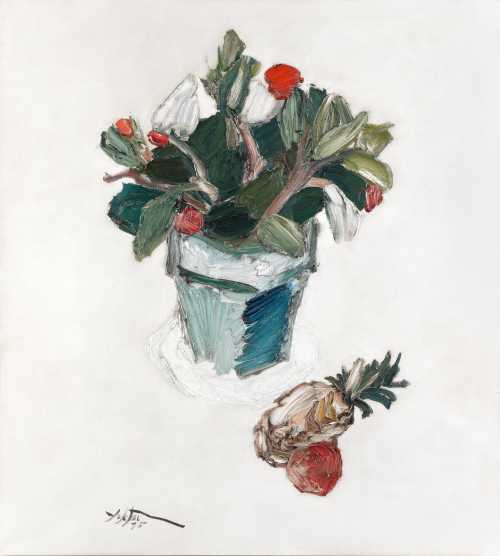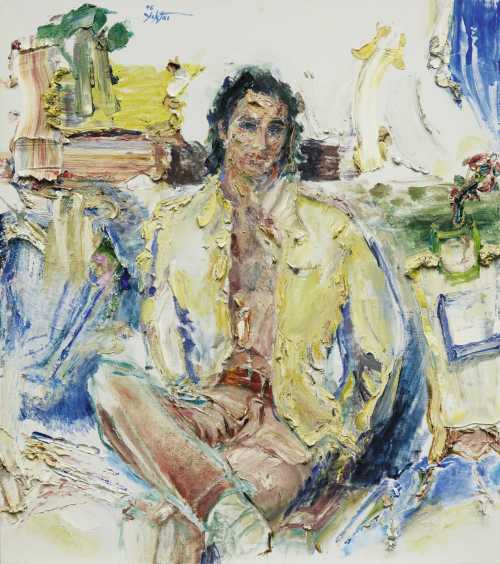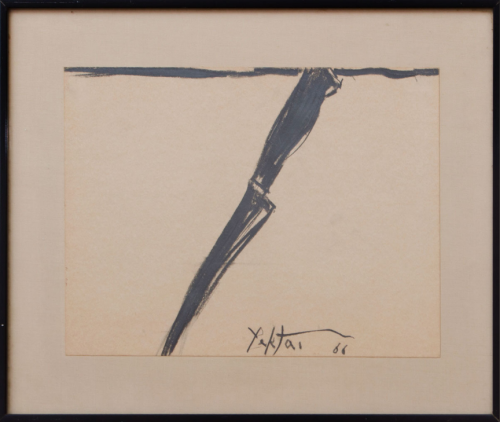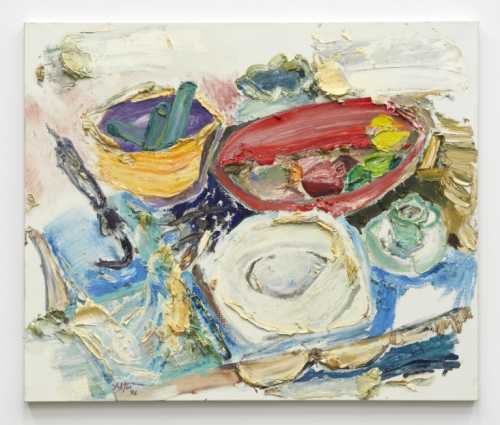- Still Life with Pineapple 1975
- Oil on canvas
- Painting
- 91 * 101 cm
- Signed "Yektai 75" lower left, executed in 1975
Framed
Estimation
£30,000
41,935 USD
-
£50,000
69,891 USD
Realized Price
£52,750
73,735 USD
31.875%
Artwork Description
"Yektai wanted to render us conscious of our existence from second to second, of the joy of breathing, of the rapid changes of things" – John Ashberry
Bonhams have the rare honour of presenting one of the most formidable examples of Manoucher Yektai's inimitable and striking expressionist still life compositions. A painting of remarkable pedigree, "Still Life Pineapple" comes back to the market for the first time since being acquired directly from the artist
Monumental, powerful and enigmatic, "Still Life With Pineapple" exhibits all the lyrical intensity of Yektai's dramatic technique; an artist at the creative high point of his career, Yektai's work is exemplified by exhilarating lyric flurries of paint, thick rapier like strokes, and a virtuoso handling of impasto.
Typical of his later more tightly ordered, paired down still life compositions "Still Life With Pineapple", is imbued with a palpable sense of grace and serenity. Whilst we may notice the influence of action painting on Yektai's style with its powerful, energetic technique evident in the torrent of lush impastoed strokes which emanate from the vase, this painterly looseness is channeled within a well-contained, tight composition – the unlikely harmony of freedom and discipline writ large in paint.
Born in Tehran, Yektai is considered one of the unsung founders of the New York School of Abstract Expressionism. After an early encounter with Iranian painter Mehdi Vishkaei, Yektai decided almost overnight to become an artist, failing to show up for his school exams one morning and proclaiming that he was destined to be a painter.
Renowned for shunning easel painting, Yektai's habit of working his canvases from the floor stem from a painting session in the outskirts of Tehran in the 1930's, where he found himself unable to work with his canvas propped against a tree due to the wind, ending up finishing the composition on the ground, a method that would stay with him for his whole career, and one to which he attributes much of his dynamism and artistic freedom.
Between 1945 and 1947, he studied with Amédée Ozenfant in Paris, France, and later in New York City. In 1951 and 1952 Leo Castelli brought some friends, including early Abstract-Expressionist painters, to see Yektai's New York exhibitions shows. Castelli introduced him to the 9th Street Club in 1951 and he soon became a friend of Rothko,Tobey, Guston, and others. In the mid-1950S he was included in classic group exhibitions of early Abstract-Expressionism at the Stable Gallery and elsewhere, with older generation artists such as DeKooning, Pollock, Newman, and Kline. From 1957 till 1965 he showed at Poindexter. With this background it would be easy to regard Yektai as a key member of the New York School.
Conceptually and stylistically, the present work is a fascinating example of the very subtle sense of tension between naturalism and abstraction manifest in Yektais work. Firmly established as one of the founding members of the New York School of Abstract Expressionism, Yektai's work was shaped and informed by his artistic milieu: luminaries such as Rothko, Pollock, De Kooning and Kline.
It is notable however that throughout his work the submission to abstraction is never complete, and that the artists love and appreciation of tangible forms ensures a strong presence of naturalism in his compositions. Yektai's desire not to forsake the identity of his surroundings, ultimately, his attachment to natural forms would not grant abstraction a total victory, and it is in this tension that his artistic sincerity is most deeply revealed.
More lots by Manoucher Yektai
Realized Price
59,994 USD
Min Estimate
28,588 USD
Max Estimate
40,958 USD
Average Artwork Worth
+273.43%
Average Growth of Artwork Worth
Sales Performance Against Estimates
Average & Median Sold Lot Value
2020 - 2024
Performance vs. Estimate
2020 - 2024
Sell-through Rate
2020 - 2024
Similar Artworks
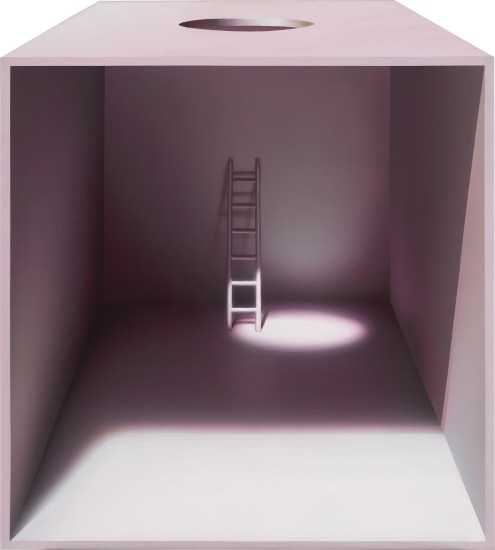
The Eternal Gate
Estimation
HK$180,000
23,047 USD
-
HK$280,000
35,851 USD
Realized Price
HK$482,600
61,793 USD
109.826%
Sell at
Sale Date
Phillips Auction
-
26 November 2023
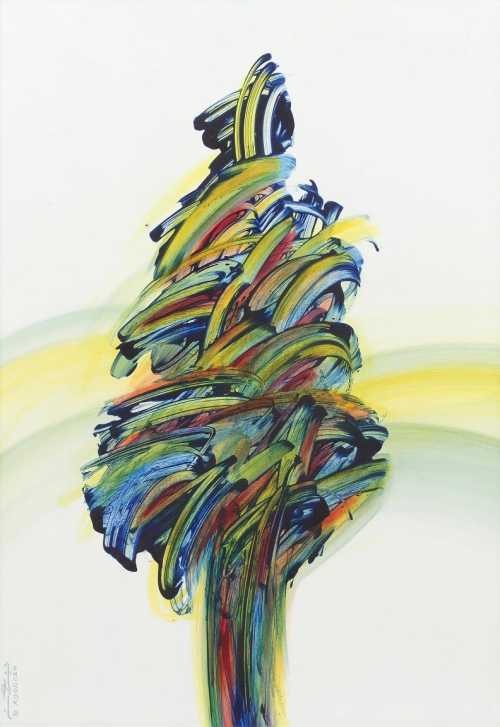
Untitled (Tree)
Estimation
£30,000
38,885 USD
-
£50,000
64,809 USD
Realized Price
£57,550
74,595 USD
43.875%
Sale Date
Bonhams
-
13 November 2024
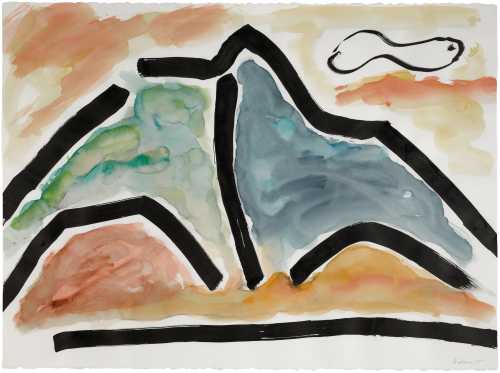
Untitled (Mount Tamalpais)
Estimation
£20,000
24,854 USD
-
£30,000
37,281 USD
Realized Price
£57,150
71,020 USD
128.6%
Sell at
Sale Date
Sotheby's
-
27 April 2023
